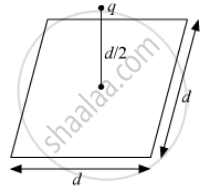Advertisements
Advertisements
प्रश्न
"For any charge configuration, equipotential surface through a point is normal to the electric field." Justify.
उत्तर
We know that the work done (W) in moving a test charge along an equipotential surface is zero. This is because an equipotential surface is a surface with a constant value of potential
at all the points on the surface.
∴ W = Fs cosθ = 0
Here, F is the electric force and s is the magnitude of displacement of the charge.
For non-zero displacement, this is possible only when cosθ is equal to 0.
i.e. cosθ = 0
⇒θ = 90°
Thus, the force acting on the point charge is perpendicular to the equipotential surface. We know that the lines of force or the electric field lines indicate the direction of electric force on a charge. Thus, for any charge configuration, equipotential surface through a point is normal to the electric field.
APPEARS IN
संबंधित प्रश्न
A point charge causes an electric flux of −1.0 × 103 Nm2/C to pass through a spherical Gaussian surface of 10.0 cm radius centred on the charge.
- If the radius of the Gaussian surface were doubled, how much flux would pass through the surface?
- What is the value of the point charge?
A point charge q is at a distance of d/2 directly above the centre of a square of side d, as shown the figure. Use Gauss' law to obtain the expression for the electric flux through the square.

Find the work done in bringing a charge q from perpendicular distance r1 to r2 (r2 > r1)
A closed surface in vacuum encloses charges –q and +3q. The total electric flux emerging out of the surface is :
State Gauss’Law.
Which statement is true for Gauss law -
Two wires A and B of the same material and of equal length with the radii in the ratio 1 : 2 are subjected to identical loads. If the length of A increases by 8 mm, then the increase in length of B is:
If the ratio of radii of two wires of same material is 3 : 1 and ratio of their lengths is 5 : 1, then the ratio of the normal forces that will produce the same extension in the length of two wires is:
The electric field inside a spherical shell of uniform surface charge density is ______.
Draw a graph of kinetic energy as a function of linear charge density λ.
